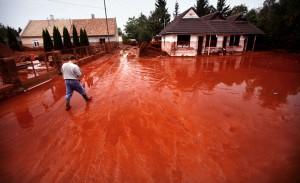Clean-upsCanadian company offers the first treatment to neutralize red mud
Red mud is the most significant waste product of the traditional Bayer process for aluminum production; the industry produces more than 100 million tons of red mud a year, of which less than 5 percent is be reused; the rest is stored in ponds and reservoirs, posing serious environmental and economic risk; on 4 October 2010, for example, a flood of toxic red mud devastated Hungary after a retaining dyke ruptured, causing an ecological disaster; Canadian company Orbite Aluminae offers a technology to tackle the aluminum industry’s most serious problem

Toxic red mud floods Hungarian village following dam burst // Source: unescovietnam.vn
Montréal, Québec-based Canadian clean tech company Orbite Aluminae Inc. announced that it has developed a patented technology that can treat red mud, the most significant waste product of the traditional Bayer process for aluminum production. Orbite says that it thus offers the only ecologically sound and commercially viable alternative to manage and eliminate these toxic residues.
According to the International Committee for Study of Bauxite, Alumina and Aluminium (ICSOBA), alumina producers generated in 2011 alone more than 100 million tons of red mud of which only 5 percent was reused. The rest is stored in ponds and reservoirs, entailing significant environmental risks. For example, on 4 October 2010, a flood of toxic red mud devastated Hungary after a retaining dyke ruptured, causing an ecological disaster. India, China, Canada, and Brasil have also been affected by spills.
The environmental and social costs associated with the Bayer process and global aluminum production have become so high that several countries now oppose the development of new mining and production facilities.
Orbite’s technology converts red mud into a dry, inert, and most importantly, environmentally neutral residue that is less than 10 percent the volume of its original state. High commercial value products are also recuperated in this process, including alumina (which can make up 25 percent of red mud), ultra-pure hematite (which is what gives the toxic residue its red color), and magnesium oxide, as well as rare metal oxides that can have significant residual economic value.
Orbite says it has developed a large-scale industrial process capable of treating red mud while individually recovering its main components.
Orbite now intends to license its technology to producers interested in reducing their environmental footprint and their risk of contamination.
